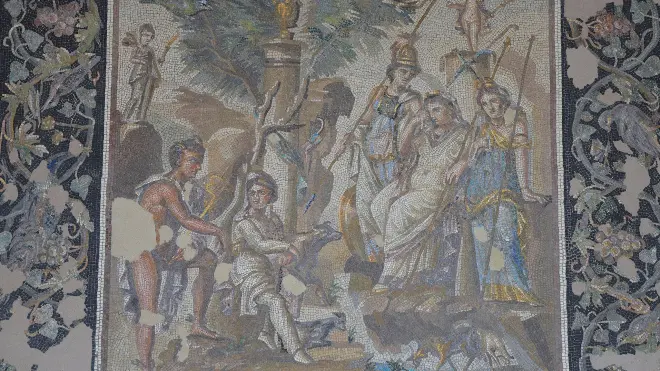【简译】安条克(安提阿、安塔基雅或安提约基雅)

Antioch or Antiochia was an ancient city located on the Orontes River near the Amanus Mountains in Syria. The “land of four cities” - Seleucia, Apamea, Laodicea, and Antiochia - was founded by Seleucus I Nicator (Victor) between 301 and 299 BCE. Some credit the city's initial founding as Antigoneia to Antigonus I the One-Eyed who lost the area to Seleucus after the Battle of Ipsus in 301 BCE. According to some ancient sources, Seleucus was considered one of the more capable successors to the empire established by Alexander the Great. Seleucus was not one of the people in Alexander's inner circle, serving as one of the commanders of the hypaspists, an elect guard that served as a buffer between Alexander's cavalry and infantry. Although little mention is made of him and his relationship to Alexander, he and his descendants would rule an empire which included Antioch for almost 250 years.
安条克或安提约基雅,位于叙利亚阿马努斯山脉附近的奥伦特河畔的一座古城。“四城之地”——塞琉西亚、阿帕米亚、老底嘉和安条克——是由塞琉古一世·尼卡托尔(维克多)在公元前301年至299年之间建立的。有些人认为该城市最初作为安提柯尼亚的建立,与“独眼巨人”安提柯一世有关,他在公元前301年的伊普苏斯战役后将该地区输给了塞琉古一世。根据一些古代资料,亚历山大大帝建立的帝国,其继承者之一应该是更有能力的塞琉古。塞琉古不是亚历山大的核心圈子里的人,他是帝国持盾卫队的指挥官之一,持盾卫队是一个作为亚历山大的骑兵与步兵之间缓冲区的选民卫队。虽然很少有人提到塞琉古或塞琉古与亚历山大的关系,但塞琉古和他的后代将统治一个包括安条克在内的帝国,长达近250年。

继承者之战
After Alexander's death in 323 BCE, his empire and its future lay in ruin. Because Alexander had not named a successor, one of his generals, Perdiccas, wanted to delay any decision concerning the naming of a new leader until after the birth of Alexander and Roxanne's child. Another general, Ptolemy I, on the other hand, wanted the empire divided immediately (he had his eye on Egypt) - the Wars of the Diadochi began and would continue for almost three decades. After Ptolemy stole Alexander's body on its way to Macedonia and took it to Alexandria, Perdiccas and his army attacked Ptolemy and his forces in Egypt. Seleucus, although initially loyal to Perdiccas, turned and sided with Ptolemy. After the defeat and death of Perdiccas, Seleucus was rewarded for his loyalty with the territory surrounding Babylon, an area east of Syria.
公元前323年,亚历山大去世,他的帝国在未来陷入毁灭。由于亚历山大没有指定继任者,他的将军佩尔狄卡斯想把有关指定新领导人的决定推迟到亚历山大和罗克珊娜的孩子出生之后。而另一位将军托勒密则希望帝国立即分裂(他看中了埃及)——继承者战争开始了,这场战争持续了近30年。托勒密在前往马其顿的路上偷偷运走了亚历山大的尸体,并将其带到亚历山大城,佩尔狄卡斯和他的军队袭击了托勒密和他在埃及的军队。塞琉古最初效忠于佩尔狄卡斯,后来转而站在了托勒密一边。在佩尔狄卡斯战败和死亡后,塞琉古因其忠诚而获得了巴比伦周围的领土,即叙利亚东部地区。
Seleucus was unable to maintain control of his newly-acquired territory and when it was invaded by his nemesis Antigonus the One-Eyed, he sought help from Ptolemy. In 312 BC Seleucus finally defeated Antigonus at the Battle of Gaza and regained his realm. After the Battle of Ipsus, he proved himself a very capable commander by expanding his empire into Syria, Asia Minor, and India. His son, Antiochus I (281-261 BCE) faced a series of revolts after his father's assassination in 281 BCE and was forced to concede territory in order to maintain peace. Unfortunately, his son, Antiochus II, (261-247 BCE) inherited a war against the Ptolemaic Dynasty of Egypt, the Second Syrian War, from his father.
塞琉古无法维持对其新获得的领土的控制。当它被死敌 “独眼巨人”安提柯入侵时,塞琉古向托勒密寻求帮助。公元前312年,塞琉古在加沙之战中击败了安提柯,重新获得了叙利亚的领地。伊普苏斯之战后,他将自己的帝国扩展到叙利亚、小亚细亚和印度,证明自己是一个非常有能力的指挥官。他的儿子安条克一世(公元前281-261年)在父亲于公元前281年被暗杀后,面临一系列的叛乱,为了维持和平局势,他被迫让出叙利亚的领土。不幸的是,他的儿子安条克二世(公元前261-247年)从他父亲(一世)那里继承了一场针对埃及托勒密王朝的战争,即第二次叙利亚战争。
In an attempt to make peace, Antiochus II agreed to divorce and exile his wife Laodice and their sons to marry Ptolemy II's daughter, Berenice Syra. When he died, his wife (Berenice) and ex-wife (Laodice) fought over whose son should be named heir. Berenice, who had the support of the people of Antioch, asked her brother and new ruler of Egypt, Ptolemy III, to help secure her infant son's right to sit on the throne. When Ptolemy arrived in Antioch, he found his sister and nephew had been assassinated. A war, the Third Syrian War or Laodicean War, erupted. Peace brought control of the port of Antioch, Seleucia, to Ptolemy, but Seleucus II (Antiochus and Laodice's son) inherited the throne and was able to retain Antioch, making it his empire's new capital.
为了谋取和平,安条克二世同意与妻子劳迪丝离婚并流放他们的儿子,与托勒密二世的女儿贝伦妮斯结婚。安条克二世死后,他的妻子(Berenice)和前妻(Laodice)为谁的儿子应该被指定为继承人而争吵。得到安条克人民支持的贝伦妮斯请求她的哥哥和埃及的新统治者托勒密三世帮助确保她的幼子坐上王位。当托勒密到达安条克时,他发现他的姐姐和侄子都被暗杀了。一场战争,即第三次叙利亚战争(老底嘉战争),爆发了。和平给托勒密带来了对安条克港口塞琉西亚的控制权,但塞琉古二世(安条克二世和劳迪丝的儿子)继承了王位,并得以保留安条克,使之成为帝国的新首都。

罗马-安条克
The city would maintain its status as a capital well into the time of the Roman Empire. Because of its location on several major trade routes (primarily the spice trade), the city and its international population served as a strategic, economic and intellectual center for both the Seleucid Empire as well as Rome. The city's importance to the Roman Empire sometimes rivaled that of Egypt's chief city Alexandria.
该城作为首都的地位将一直保持到罗马帝国时期。由于它位于几条主要的贸易路线上(主要是香料贸易),该城及其国际人口成为塞琉古帝国和罗马的战略、经济与知识中心。该城对罗马帝国的重要性有时可与埃及的主要城市亚历山大媲美。
Due to the reign of several feeble rulers, in 64 BCE Pompey made the region a Roman province. As with other Roman cities, the city would benefit from Roman rule. Antioch would become Romanized containing aqueducts, Roman baths, and even an amphitheater. Its sumptuous palaces (built by the Seleucid monarchs) became vacation residences of many Roman emperors. Septimius Severus took away the city's independence when they supported Pescennius Niger of Syria instead of him for Roman emperor. Because it was located on a major fault, the city was damaged by both a great fire and several earthquakes (earthquakes occurred under Tiberius, Caligula, Hadrian, and Diocletian).
由于几个孱弱的统治者的统治,公元前64年,庞培将该地区变成了罗马的省。与其他罗马城市一样,该城市将从罗马统治中受益。安条克逐渐成为罗马化的城市,城市里新建了包括水渠、罗马浴场等罗马式建筑,甚至还有一个圆形剧场。其奢华的宫殿(由塞流西德的君主建造)成为许多罗马皇帝的度假住所。塞提米乌斯·塞维鲁斯(Septimius Severus)在支持叙利亚的佩斯切尼乌斯·奈哲尔(Pescennius Niger)而不是其做罗马皇帝时,剥夺了该城的独立性。由于它位于一个主要的地质断层上,该城被一场大火和几次地震所破坏(地震发生在提比略、卡利古拉、哈德良和戴克里先时期)。
Antioch was rebuilt by the Roman emperor Trajan, serving as the Roman army's winter quarters. After the empire was divided during the reign of Diocletian, the city fell into the Byzantine half or the Eastern Roman Empire. Under the rule of Constantine, it would be a leading city in the rise of Christianity, even containing a school for biblical studies. When the last pagan emperor, Julian the Apostate (361-363 CE) passed through Syria on his way to fight the Persians, he stopped at Antioch in 362 CE. The city was forced to house and feed his army. The resulting crisis over the price of grain eventually led to both a famine and food riots. Later, it would be sacked by the Huns in the 5th century CE and eventually captured by the Arabs in the 7th century CE.
安条克在罗马皇帝图拉真时期重建,作为罗马军队的冬季驻地。在戴克里先统治时期帝国被分裂后,该城落入拜占庭手中(东罗马帝国)。在君士坦丁的统治下,它成为基督教兴起的主要城市,这里甚至建造了一所研究圣经的学校。当最后一位异教皇帝朱利安(Julian the Apostate,公元361-363年)在与波斯人作战的途中经过叙利亚时,他于公元362年在安条克停留。这座城市被迫为他的军队提供住所和食物。由此产生的粮食价格危机最终导致了饥荒和骚乱。后来,它在公元5世纪被匈奴人洗劫,最终在公元7世纪被阿拉伯人占领。

参考书目:
Anonymous. Encyclopedia of World History.
Bagnall, R.S. et al. Encyclopedia of Ancient History. Wiley-Blackwell, London, 2012
Livius. Articles on Ancient History.

原文作者:Donald L. Wasson
唐纳德曾在林肯学院(伊利诺伊州普通市)教授古代、中世纪和美国历史。
原文网址:https://www.worldhistory.org/trans/es/1-11771/antioquia/


